Performance
I tested the Lumu against a Spectra Cine Professional IV-A, Gossen Starlite, and Cine Meter II with the Luxi incident photosphere (which stands in for the relative performance of any iPhone app using Luxi for incident readings). I also shot stills with a Panasonic GH4 based on Lumu’s recommended exposures.
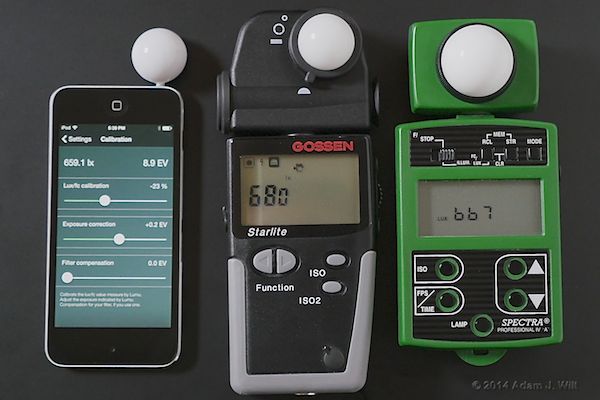
Calibrating Lumu with two “real” lightmeters, all showing Lux.
“A man with one lightmeter knows what the light level is. A man with two lightmeters is never sure.” Two meters rarely agree exactly, but close enough is close enough. In this case, the two “real” meters disagree by about 2%, well within acceptable limits, and Lumu could be set to match reasonably well. In calibration mode, Lumu’s Lux reading is constantly varying; here it was wiggling around 670 on average, though my shutter caught it at 659.1.
I calibrated (or cross-checked) all my meters in a even lighting field (less than 1/10 stop variation on any single meter placed at any position in my measurement setup), lit with Kino-flo Diva-lite 400s with daylight-balanced tubes, as well as outdoors under direct sunlight near noon, in open shade under a blue sky, and at night under whatevertherheck sort of discontinuous-spectrum streetlighting my block has (high pressure sodium vapor I think, but I’m not certain).
Calibrations are portable: calibrations set on one device work on all other devices for the same Lumu sensor. Once I dialed the Lumu in on my iPod touch 5G, the same settings on my iPod 4G, iPhone 5, and Galaxy S II gave the the same readings.
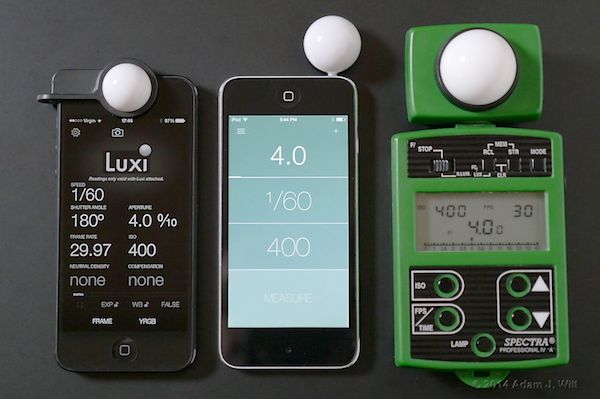
Taking readings with three meters. Exposure based on Lumu reading.
For the most part, I used the Lumu (still photo) app on three iDevices running iOS 6 and iOS 7.1.2, as the first version of Lumu Video could not be calibrated during video-mode measurement (Lumu Video version 1.1.1, released August 9, fixes this problem).
Under “daylight” lighting, I found that I needed a calibration of -23% on the Lux scale, and an exposure correction of +0.2 EV. With those settings, Lumu tracked my other meters within 0.2 stop over a wide range of brightnesses.
Brightness accuracy: Lumu matched my two “real” meters (and Cine Meter II) within 0.2 stop from dim room lighting and outdoor residential streetlighting all the way up to full noonday sunlight. By comparison, the two “real” meters themselves varied within 0.2 stop of each other: sometimes the Gossen read 0.1 stop brighter than the Spectra, sometimes it was 0.1 stop darker. Essentially, the Lumu was as accurate as the other two within the limits of my testing, as it was always within 0.1 stop of one meter or the other.
Angular accuracy: Lumu’s angular sensitivity – its measurement when light comes at it head-on, from the side, or from behind as a grazing backlight or edge-light – matched the two “real” meters within 0.2 stop at all angles. Cine Meter II with Lumu, by contrast, tended to be slightly oversensitive to quartering toplight (key light coming from 45º above and behind the meter’s photosphere), reading 0.3-0.4 stop more sensitive, though 45º quartering sidelight readings were closer: the body of the iPhone blocks much of the grazing backlight when it comes from the side (see the image above).
Range and sensitivity: Lumu Labs specifies that Lumu can read light from 0.15 Lux to 250,000 Lux. By comparison, the full moon lights a scene to around 0.27 – 1.0 Lux while full sunlight is 32,000 – 100,000 lux. Right now (10:30pm, clear skies), the full moon reads 0.3 – 0.4 Lux on Lumu. Earlier today (4pm, thin overcast) I measured 90,000 lux outside, so I don’t think I’m going to be able to exceed Lumu’s upper limits.
The Spectra’s spec sheet says it can read anywhere from 1 – 100,000 Lux, less than Lumu’s range. The Gossen’s specs for incident readings at ISO 100 are EV -2.5 to EV +18 while the Lumu is rated for EV -4 to EV +20 at ISO 100; again, the Lumu wins.
I compared Lumu’s low-light limits to my other meters, using exposure readings as a more natural readout (for shooters) than Lux. I’ve normalized all exposures to ISO 12500 (or ISO 12800) at 1 second, though not all meters’ ISO settings go that high or their speeds that low, for ease of comparison. The lower limits were determined by taking readings down to where the level didn’t change even if I wrapped my hand around the photosphere.
Lumu will read light down to ISO 12500, 1 second exposure at f/1.0 (and yes, I shot a very noisy and blurry still on my GH4 at that setting, and the exposure looked correct).
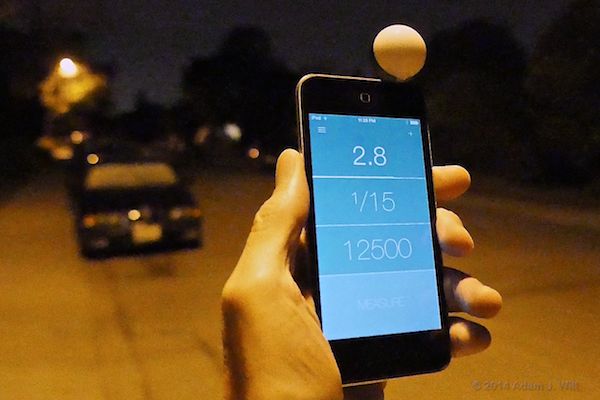
Lumu in low light. Exposure based on Lumu reading.
(This exposure is the darkest shot I have in which you can still read the Lumu screen; the iPod is already at its dimmest setting, and even so, I had to angle it away from the camera to keep it from washing out.)
The Spectra Pro IV runs out of steam at the equivalent exposure of ISO 12500, 1″, f/1.0 & 7/10 stop, or 0.7 stop brighter than Lumu.
The Gossen Starlite gives up at 12500, 1″, f/4.0 & 5/10, or 4.5 stops brighter than Lumu.
Various iPhone and iPod front and rear cameras, with Luxi, stop reading anywhere from 4.0 to 6.1 stops brighter than Lumu.
Lumu bests the iPhone and iPod cameras easily in low light, and sees darker than my other two meters can, too.
Temperature compensation: Lumu Labs says the Lumu works from 14ºF to 122ºF (-20ºC to 60ºC). I put Lumu in the refrigerator (around 40ºF) for an hour and tried it; I also let it sit outside, black back in full sunlight on a 98ºF day, until it was almost too hot to touch. In neither case did the light reading vary from what my “real”, non-mistreated meters said. Temperature compensation appears to be perfectly accurate within the limits of my test.
Color sensitivity: I found that my Lumu readings under incandescent light weren’t tracking my other meters, being 0.5 – 0.7 stops less sensitive than the “real” meters were (by comparison, the Gossen meter differed from the Spectra by a total of 0.2 stop when moving from daylight to tungsten lighting), so I ran more calibration tests.
Under tungsten cine lighting (Lowel Tota-lites with 750w bulbs, nominally 3200K) I needed a Lux calibration of +24%. With a household incandescent (150w PAR in a ceiling can, one of the few glowing-filament lights left in the house), I needed a Lux calibration of around +19%; under a “daylight” LED source (the LED flood in the next ceiling can), around -9%. The latter two measurements were made at “eye height” – the height of the rabbit’s eye in the picture below – directly under each of the two luminaires in question, but not shielded from spill light from the adjacent luminaire:
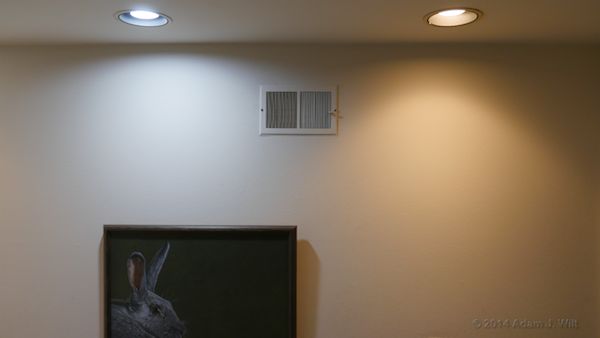
Mixed lighting: “daylight” LED vs. tungsten PAR.
Interestingly, the default 0% Lux calibration for the Lumu falls right between my pure-daylight calibration of -23% and pure-tungsten setting of +24%. With the default calibration, Lumu reads about 0.3 stop more sensitive than my other meters under daylight conditions and 0.3 stop less sensitive under tungsten (I don’t know if they all do that, or if it’s just my single sample).
(Note that 0.3 stop is a very minimal difference in most real-world situations; unless you’re trying to match exposures between daylight shots and tungsten shots, you’ll probably never notice it. Neither should a 1/3-stop difference have a deleterious effect on your exposures.)
I went a step further: I compared measurements and shot pix under colored lighting generated by Ben Syverson’s Catchlight app, which let me set an iPad screen to radiate “white” light, saturated colors, or anything in between. I wasn’t very precise; I dragged the color setting to generate primary and secondary colors by eye, but I can’t guarantee that (for example) the red I got was “pure” red, RGB=255,0,0. I also haven’t measured the iPad with a spectrophotometer, so I can’t speak to the purity of the LED backlighting or its spectral continuity. Thus my finding here are indicative rather than definitive: these are the sorts of things you might see under similar lighting conditions, but they are not findings that you can use to predict performance under light of a particular color or spectral composition.
What I found was that the Lumu, using my daylight calibration, was about half a stop more sensitive to saturated green light than my other meters; tracked my other meters closely for white, blue, magenta, cyan, and yellow light; and fell short for orange and red sources: at worst, Lumu was nearly three stops less sensitive than my other meters for a “pure” red source, where I set the iPad to emit saturated red light.
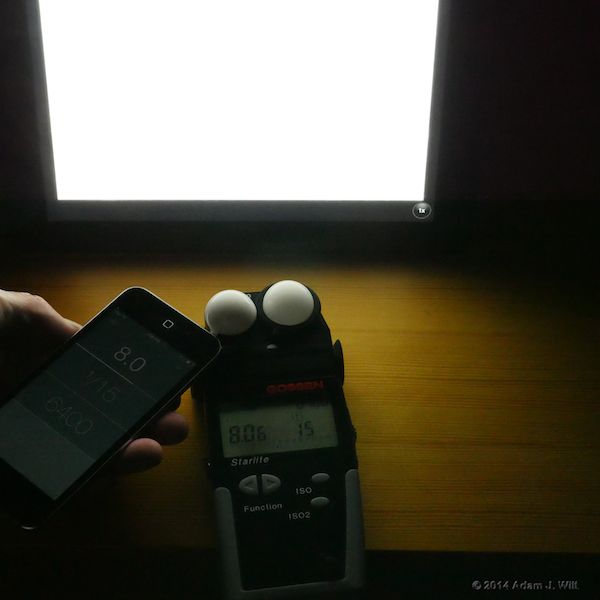
“Pure” white light, roughly 5600K: readings match.
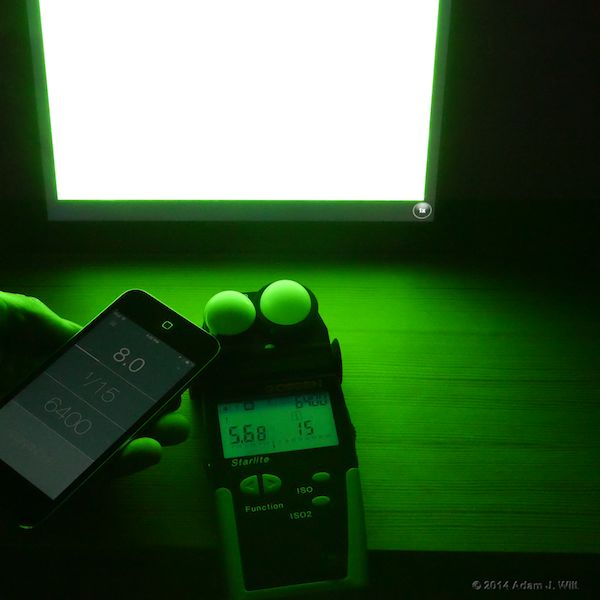
“Pure” green light: Lumu reads 0.4 – 0.5 stop hotter than Gossen.
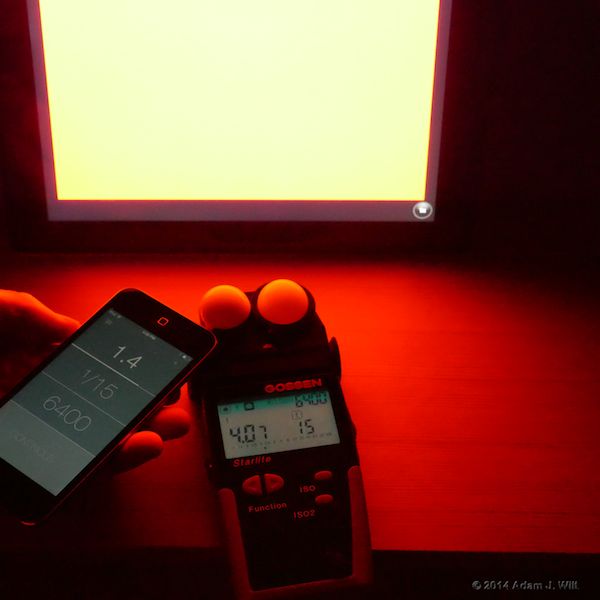
“Pure” red light: Lumu is almost 3 stops under the Gossen’s reading.
It appears the Lumu’s sensor is mostly sensitive to short wavelengths from the violet end of the spectrum down through green and yellow, and less sensitive to reds and oranges. That explains why it’s 0.5-0.7 stop less sensitive under tungsten compared to daylight; tungsten has a lot more of its energy in the red end of the spectrum.
Conclusions
Sorry, I won’t give you any. I’ll list the Pros and Cautions, and leave you to make up your own mind.
Why? Two reasons.
First, I sell an app that (a) may be in competition with Lumu and/or (b) would benefit from integrating it, or from promoting the idea of iPhone light metering in the first place. In case (a), any negative opinion could be taken as being motivated by a conflict of interest; in case (b) anything positive I say could be seen as being overly influenced in the opposite direction.
Second, I honestly don’t know how much of an issue Lumu’s color response is. When I showed off Cine Meter II’s sixth-stop metering to two respected industry observers (Art Adams and Gary Adcock), they both gave me odd looks, saying that measurements that precise simply weren’t useful: half-stops, sure; third-stops, maybe; but anything more finicky wasn’t necessary from a practical standpoint: you won’t see much of a difference onscreen, even if your 1st AC manages to set the stop that precisely to begin with. With that in mind, how important, practically speaking, is the 0.5 – 0.7 stop difference between Lumu under daylight and Lumu under tungsten?
By the same token, does anyone use an incident meter under saturated, single-color lighting? I’ve never trusted incident readings under saturated lighting myself; unless I’m shooting grayscale charts, my subject is almost always colored one way or another, and thus greatly affected by the lighting color: skintones brighten under red/orange light and go much darker under blue light, so I normally use reflected metering in those conditions. So again, the question is: is Lumu’s color sensitivity a serious practical concern?
Finally, given all that: should I add Lumu capability to Cine Meter II? Please, let me know what you think.
Pros
- Very wide brightness range
- Highly accurate when calibrated under a given lighting source
- Accurate readings even with grazing backlight and sidelight
- Temperature-compensated for accuracy whether cold or hot
- Rotatable: you can spin Lumu to read from any direction while still holding your device so you can read it
- Usable on devices without cameras; calibration independent of a device’s cameras
- Works on any iOS device with sufficiently recent firmware; works on several Android devices [though the apps are no longer available for download]
- Excellent build quality; elegant packaging with handy neck lanyard and leather storage pouch
Cautions
- Not all Android devices are supported, and unless your ‘droid has been proven to work, compatibility is uncertain [as of 2016, Lumu no longer supports Android and the apps are no longer in Google Play.]
- Lumu is color-sensitive, with 0.5 – 0.7 stop higher sensitivity under daylight than under tungsten
- Lumu’s sensitivity peaks under green light, and falls off under orange and red light
Disclosure: Lumu Labs sent me a Lumu for evaluation, so that I could look into supporting Lumu in Cine Meter II, but they have not encouraged me to write a review and aren’t offering any payment or consideration for doing so.
Even so, you might feel – with understandable justification – that I have a dog in this fight, and can’t be trusted to be objective. I hope I’ve been up-front enough with the context of my review, and hands-off enough in making subjective statements, to alleviate those concerns. My intent, despite any potential conflict/confluence of interests, is to present what I’ve found in as straightforward, honest, and unbiased a way as I can. I hope that this writeup informs people about Lumu; I additionally hope to get useful feedback as to whether or not I should add Lumu metering to Cine Meter II.
